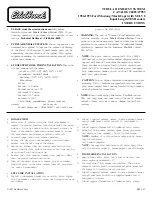
Page 69
Figure 10 Determining overall differential end float using
gauging tool
1.
Gauging nut
2.
Locking nut
7.
Remove the pinion flange nyloc nut and washer and
withdraw the flange. Tap the pinion assembly in to centre of the axle
and remove.
8.
Using hand press tool No. 47 and pinion bearing remover
tool RT 8765, follow the same procedure as the differential unit and
remove the pinion bearing. (
Figure 8
). Note the value of the spacing
washer thickness next to the pinion head plus any additional shims.
9.
Following the earlier procedure, remove the left-hand
brake assembly and the left-hand half shaft.
10.
Using the three legged puller tool No. RT 3072-1 on slide
hammer tool No. 3072, remove the axle housing outer bearing cones
(
Figure 9
).
11.
Should the pinion outer bearing tracks need replacement,
remove with a suitable drift after gently heating the appropriate area
of the casting.
12.
The pinion flange oil seal will come away when the rear
bearing is removed.
Operation 4
Re-assembly - determining the overall
differential end float.
1.
Thoroughly clean all dismantled components.
2.
Place two dummy bearings RT 8732 on the ends of the
differential carrier without any shims and assemble in the actual
casing. Secure the two halves of the axle case.
3.
Check that the differential unit rotates freely.
4.
Note:
The gauging tool RT 8732used to determine the
overall differential end float, designed originally for the Robin axle,
can be modified to fit the Kitten axle as explained at the end of this
section. The following sequence describes the use of this modified
tool.
Assemble the components of the tool, screwing the circular plates on
to the push rods. Insert these through the axle tube, ensuring that the
swivel pad on each end is felt to locate in each side of the differential
carrier bore. Screw plates up to the axle tube and secure with the bolt
supplied. Unscrew both rods slightly before finally clamping the plate.
The two round knurled gauging nuts should be screwed on to the push
rod, which is facing the crown wheel or pinion side of the crown wheel
which, for convenience of explanation, should be on the left-hand side
Figure 11 Measuring the torque to turn the pinion using dummy
Pinion tool
1.
Pinion setting tool
of the operator as they face the axle and referred to as the left-hand
side throughout these instructions.
5.
Unscrew the right-hand side push rod approximately 3.2
mm (1/8 in). Screw in the left-hand push rod with a load of 2-4 lb/ft
maximum, thus pushing the differential assembly over in to the right-
hand housing. Screw up the gauging nut lightly to the face of the
circular plate. Carefully screw the locking nut up to the gauging nut
and screw the push rod back approximately 3.2 mm (1/8 in), ensuring
the gauge nuts move with the screw as they come away from the
plate. Screw in the right-hand push rod 2-4 lb/ft maximum, thus
pushing the differential unit in to the left-hand axle housing. Screw in
the left-hand push rod until a stop is felt. Measure the gap between
the circular plate and the gauge nut with a feeler gauge and record
the figure (
Figure 10
) which will represent the overall end float.
6.
Separate the casings and remove the differential assembly
complete with dummy bearings , but
Do not remove the dummy
bearings from the differential carrier.
Operation 5
Re-assembly - setting the pinion
1.
Ensure the pinion bearing cups are seating correctly in the
pinion housing.
2.
Locate the thick pinion spacer washer on the dummy pinion
RT 8730 followed by the taper bearing cone.
3.
Locate the dummy pinion in the pinion housing, placing the
outer bearing cone in position, followed by the flange and the dummy
pinion nut and tighten to give the running preload, thus setting the
rollers.
4.
Place the mandrell, RT 8730 in the differential side bearing
bore. With a dial gauge torque wrench, check the torque required to
turn the dummy pinion nut (
Figure 11
). This should read 0.115 to
0.150 kg/m (10 to 13 lb/in) torque without the oil seal, 0.150 to 0.184
kg/m (13 to 16 lb/ft) with the oil seal. Ensure that the mandrell is
seating correctly and measure with feeler gauges the gap between the
outside diameter of the mandrell and the dummy pinion face (
Figure
12
). Any amount in excess of 0.030 in will be the spacers required to
bring the pinion to its correct operating distance. take in to account,
when determining the shims required, any figure stamped on the
pinion itself, which represents any variation in manufacture from the
nominal mounting distance i.e. if a figure of 0.003 is stamped on the
Содержание Kitten Estate
Страница 15: ...Page 15...
Страница 17: ...Page 17...
Страница 22: ...Page 22...
Страница 26: ...Page 26...
Страница 38: ...Page 38 Figure 4 Engine cylinder block exploded...
Страница 54: ...Page 54...
Страница 55: ...Page 55...
Страница 65: ...Page 65...
Страница 66: ...Page 66...
Страница 75: ...Page 75...
Страница 77: ...Page 77...
Страница 90: ...Page 90...
Страница 92: ...Page 92...
Страница 97: ...Page 97...
Страница 100: ...Page 100...
Страница 101: ...Page 101...
Страница 103: ...Page 103...
Страница 108: ...Page 108...
Страница 114: ...Page 114...
Страница 116: ...Page 116...
Страница 117: ...Page 117...
Страница 118: ...Page 118...
Страница 119: ...Page 119...
Страница 120: ...Page 120...
Страница 123: ...Page 123...
Страница 124: ...Page 124...
Страница 126: ...Page 126...
Страница 130: ...Page 130...
Страница 131: ...Page 131...
Страница 133: ...Page 133...
















































